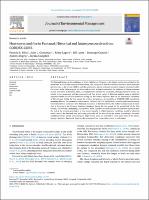Mostrar el registro sencillo del ítem
Heatwaves and fire in Pantanal: Historical and future perspectives from CORDEX-CORE
| dc.contributor.author | Silva, Patrícia S. | |
| dc.contributor.author | Geirinhas, João L. | |
| dc.contributor.author | Lapere, Rémy | |
| dc.contributor.author | Laura, Wil | |
| dc.contributor.author | Cassain, Domingo | |
| dc.contributor.author | Alegría, Andrés | |
| dc.contributor.author | Campbell, Jayaka | |
| dc.date.accessioned | 2023-12-05T14:59:24Z | |
| dc.date.available | 2023-12-05T14:59:24Z | |
| dc.date.issued | 2022 | |
| dc.identifier.uri | https://hdl.handle.net/20.500.12542/3005 | |
| dc.description.abstract | The Pantanal biome, at the confluence of Brazil, Bolivia and Paraguay, is the largest continental wetland on the planet and an invaluable reserve of biodiversity. The exceptional 2020 fire season in Pantanal drew particular attention due to the severe wildfires and the catastrophic natural and socio-economic impacts witnessed within the biome. So far, little progress has been made in order to better understand the influence of climate extremes on fire occurrence in Pantanal. Here, we evaluate how extreme hot conditions, through heatwave events, are related to the occurrence and the exacerbation of fires in this region. A historical analysis using a statistical regression model found that heatwaves during the dry season explained 82% of the interannual variability of burned area during the fire season. In a future perspective, an ensemble of CORDEX-CORE simulations assuming different Representative Concentration Pathways (RCP2.6 and RCP8.5), reveal a significant increasing trend in heatwave occurrence over Pantanal. Compared to historical levels, the RCP2.6 scenario leads to more than a doubling in the Pantanal heatwave incidence during the dry season by the second half of the 21st century, followed by a plateauing. Alternatively, RCP8.5 projects a steady increase of heatwave incidence until the end of the century, pointing to a very severe scenario in which heatwave conditions would be observed nearly over all the Pantanal area and during practically all the days of the dry season. Accordingly, favorable conditions for fire spread and consequent large burned areas are expected to occur more often in the future, posing a dramatic short-term threat to the ecosystem if no preservation action is undertaken. | es_PE |
| dc.format | application/pdf | es_PE |
| dc.language.iso | spa | es_PE |
| dc.publisher | Elsevier | es_PE |
| dc.relation.uri | https://www.sciencedirect.com/science/article/pii/S0301479722017662 | es_PE |
| dc.rights | info:eu-repo/semantics/openAccess | es_PE |
| dc.source | Repositorio Institucional - SENAMHI | es_PE |
| dc.source | Servicio Nacional de Meteorología e Hidrología del Perú | es_PE |
| dc.subject | Biomasa | es_PE |
| dc.subject | Biodiversity | es_PE |
| dc.subject | Ecosystem | es_PE |
| dc.subject | Wildfires | es_PE |
| dc.title | Heatwaves and fire in Pantanal: Historical and future perspectives from CORDEX-CORE | es_PE |
| dc.type | info:eu-repo/semantics/article | es_PE |
| dc.identifier.journal | Journal environmental Management | es_PE |
| dc.subject.ocde | https://purl.org/pe-repo/ocde/ford#1.05.09 | es_PE |
| dc.subject.sinia | biomasa - Biodiversidad y Ecosistemas | es_PE |
| dc.type.sinia | text/publicacion cientifica | es_PE |
| dc.identifier.url | https://hdl.handle.net/20.500.12542/3005 |
Ficheros en el ítem
Este ítem aparece en la(s) siguiente(s) colección(es)
-
Artículo científico [171]







